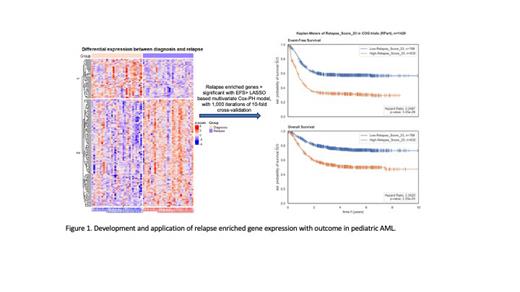Acute myeloid leukemia (AML) is a hematologic malignancy characterized by the abnormal proliferation and accumulation of immature myeloid cells. While standard induction therapy achieves remission in a substantial proportion of AML patients, relapse rates remain high, particularly in children (approximately 40%) and adults (around 70%). Despite advancements in AML treatment strategies, the management of relapsed and refractory disease remains significant clinical challenge, resulting in dismal outcomes with a three-year survival rate below 10%. Therefore, there is an urgent need to identify predictive markers for relapse and refractory AML to improve treatment outcomes. To address this urgent need, we evaluated differential gene expression in relapse vs diagnosis and its impact on outcomes.
RNA sequencing data from bone marrow samples were obtained from pediatric AML patients enrolled in four Children's Oncology Group clinical trials: AAML0531 (NCT00372593), AAML1031 (NCT01371981), AAML03P19 (NCT00070174), and CCG2961 (NCT00003790) through the Therapeutically Applicable Research to Generate Effective Treatments (TARGET) initiative. Gene expression data was batch corrected using Combat. RNA-seq data from 1441 patients available at https://portal.gdc.cancer.gov/projects/TARGET-AML were included in the current analysis of which 31 had RNA-seq data from both diagnosis and relapse and 1420 had RNA-seq data from only from diagnosis. In step 1, we identified genes differentially expressed at relapse using RNA-seq data from 31 matched diagnosis and relapse samples using wilcoxon signed rank test. At p-values <0.005, 201 genes were differentially expressed, with 147 upregulated and 54 downregulated at relapse compared to diagnosis (Figure 1). To further establish clinical relevance of these genes, we evaluated their association with event-free survival (EFS) in the 1420 patients with RNA-seq data at diagnosis (N=1420) using Cox proportional hazard model, identifying 47 genes significantly associated with EFS (p<0.05). Of these, 9 were pseudogenes, 4 had lower expression at relapse and 34 were expressed at higher levels in the relapse samples. We evaluated these 34 genes using a LASSO penalized Cox proportional hazards model, with over 1000 iterations of 10-fold cross-validation. Genes passing more than 95% of the iterations were further selected to build a relapse signature which constituted 23 genes.Notably, this signature was comprised of several important genes including TCF3, a transcription factor with known mutations in some B-cell acute lymphoblastic leukemia (B-ALL) cases; BIRC5 (Survivin), an apoptosis inhibitor whose overexpression has been linked to therapeutic resistance across cancers; PAX5, a key gene for B-cell differentiation that has identified aberrations B-ALL; BCL7A, a member of the BCL gene family associated with lymphoid malignancies, as B-cell lymphomas; and PARP1, known for its role in DNA repair and the recent therapeutic implications of its inhibitors in BRCA-mutated solid tumors.
Patients were further stratified into high and low relapse risk groups based on relapse signature scores using recursive partitioning. Patients with high relapse signature score had inferior EFS and OS as compared to those with low signature score (EFS, HR: 2.25, 95% CI 0.25-0.99, p<0.001); OS, (HR 2.35,95% CI 0.40-0.99, p<0.001), Figure 1). Multivariable Cox regression analysis further revealed that the relapse score remained a significant predictor of patient outcomes after adjusting for established risk factors including risk group, race, white blood cell count, and age at diagnosis (EFS: HR 1.64, 95% CI, 1.40-1.92, p<0.001 and OS: HR 1.62, 95% CI 1.33-1.97, p<0.001).
To validate the signature, we evaluated it in an independent cohort of 147 pediatric AML patients treated on St Jude AML08 clinical trial with RNA seq data available. Consistent with the discovery cohort, patients with high score had worse EFS (HR: 1.83, p=0.045) and tended to have lower OS (HR: 1.71, p=0.12). These results indicate the relapse-enriched gene expression signature can effectively risk-stratify newly diagnosed pediatric AML patients. Ongoing studies are focused on validating this signature in other independent cohorts, as well as integrating it with cytogenetic features and other previously reported signatures of relevance such as LSC to establish its prognostic utility.
Disclosures
Rubnitz:Biomea, Inc: Consultancy.


This feature is available to Subscribers Only
Sign In or Create an Account Close Modal